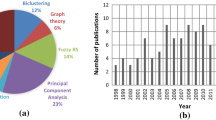Abstract
We propose a novel collaborative filtering method for top-\(n\) recommendation task using bicustering neighborhood approach. Our method takes advantage of local biclustering structure for a more precise and localized collaborative filtering. Using several important properties from the field of Formal Concept Analysis, we build user-specific biclusters that are “more personalized” to the users of interest. We create an innovative rank scoring of candidate items that combines local similarity of biclusters with global similarity. Our method is parameter-free, thus removing the need for tuning parameters. It is easily scalable and can efficiently make recommendations. We demonstrate the performance of our algorithm using several standard benchmark datasets and two paypal (in-house) datasets. Our experiments show that our method generates better recommendations compared to several state-of-the-art algorithms, especially in the presence of sparse data. Furthermore, we also demonstrated the robustness of our approach to increasing data sparsity and the number of users.



Similar content being viewed by others
References
Adomavicius G, Tuzhilin A (2005) Toward the next generation of recommender systems: a survey of the state-of-the-art and possible extensions. IEEE Trans Knowl Data Eng 17(6):734–749
Alqadah F, Bader JS, Anand R, Reddy CK (2012) Query-based biclustering using formal concept analysis. In: SDM
Alqadah F, Bhatnagar R (2009) Discovering substantial distinctions among incremental bi-clusters. In: SDM’09
Alqadah F, Bhatnagar R (2011) Similarity measures in formal concept analysis. Ann Math Artif Intell 61:245–256
Berry A, Bordat J-P, Sigayret A (2007) A local approach to concept generation. Ann Math Artif Intell 49:117–136
Cantador I, Brusilovsky P, Kuflik T (2011) 2nd workshop on information heterogeneity and fusion in recommender systems (hetrec 2011). In: RecSys 2011
Deshpande M, Karypis G (2004) Item-based top-n recommendation algorithms. ACM Trans Inf Syst 22:143–177
de Franca FO, Ferreira HM, Von Zuben FJ (2007) Applying biclustering to perform collaborative filtering. In: Proceedings of the seventh international conference on intelligent systems design and applications, ISDA ’07, pp 421–426
Yu K, Xu X, Ester M, Kriegel HP (2003) Feature weighting and instance selection for collaborative filtering. An information-theoretic approach. Knowledge and Information Systems 5(2):201–224
Gamter B, Wille R (1999) Formal concept analysis: mathematical foundations. Springer, Berlin
George T, Merugu S (2005) A scalable collaborative filtering framework based on co-clustering. In: ICDM ’05: Proceedings of the fifth IEEE international conference on data mining. IEEE computer society, pp 625–628
Hu Y, Koren Y, Volinsky C (2008) Collaborative filtering for implicit feedback datasets. In: Proceedings of the 2008 eighth IEEE international conference on data mining
Koren Y (2008) Factorization meets the neighborhood: a multifaceted collaborative filtering model. In: Proceedings of the 14th ACM SIGKDD international conference on knowledge discovery and data mining, pp 426–434
Koren Y, Bell R, Volinsky C (2009) Matrix factorization techniques for recommender systems. Computer 42(8):30–37
Leung CW, Chan SC (2006) A collaborative filtering framework based on fuzzy association rules and multiple-level similarity. Knowl Inf Syst 10:357–381
Ning X, Karypis G (2011) Slim: sparse linear methods for top-n recommender systems. In: ICDM 2011
Oard D, Kim J (1998) Implicit feedback for recommender systems. In: Proceedings of the AAAI workshop on recommender systems, pp 81–83
Odibat O, Reddy CK (2014) Efficient mining of discriminative co-clusters from gene expression data. Knowl Inf Syst (KAIS). http://link.springer.com/article/10.1007%2Fs10115-013-0684-0
Rendle S, Freudenthaler C, Gantner Z, Schmidt-Thieme L (2009) Bpr: Bayesian personalized ranking from implicit feedback. In: Proceedings of the twenty-fifth conference on uncertainty in artificial intelligence
Slobodan Vucetic ZO (2005) Collaborative filtering using a regression-based approach. Knowl Inf Syst 7:1–22
Su X, Khoshgoftaar TM (2009) A survey of collaborative filtering techniques. Adv Artif Intell 4:2–4:2
Symeonidis P, Nanopoulos A, Papadopoulos A, Manolopoulos Y (2008) Nearest-biclusters collaborative filtering with constant values. Inf Retr 11:51–75
Xue G-R, Lin C, Yang Q, Xi W, Zeng H-J, Yu Y, Chen Z ( 2005) Scalable collaborative filtering using cluster-based smoothing. In: Proceedings of the 28th annual international ACM SIGIR conference on Research and development in information retrieval, SIGIR ’05, pp 114–121
Yu H-F, Hsieh C-J, Si S, Dhillon IS (2013) Parallel matrix factorization for recommender systems. Knowl Inf Syst 1–27. http://link.springer.com/article/10.1007/s10115-013-0682-2
Zaki MJ, Ogihara M (1998) Theoretical foundations of association rules. In: 3rd SIGMOD’98 workshop on research issues in data mining and knowledge discovery (DMKD)
Acknowledgments
We would like to thank Santosh Kabbur and Xia Ning for providing us with implementations of WRMF and SLIM respectively. This work was supported in part by the National Cancer Institute of the National Institutes of Health under Award Number R21CA175974 and the US National Science Foundation Grants IIS-1231742 and IIS-1242304. The content is solely the responsibility of the authors and does not necessarily represent the official views of the NIH and NSF.
Author information
Authors and Affiliations
Corresponding author
Rights and permissions
About this article
Cite this article
Alqadah, F., Reddy, C.K., Hu, J. et al. Biclustering neighborhood-based collaborative filtering method for top-n recommender systems. Knowl Inf Syst 44, 475–491 (2015). https://doi.org/10.1007/s10115-014-0771-x
Received:
Revised:
Accepted:
Published:
Issue Date:
DOI: https://doi.org/10.1007/s10115-014-0771-x




